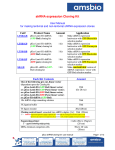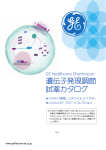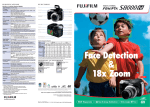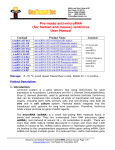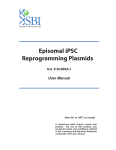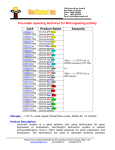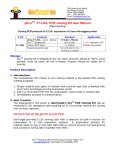Download GenTarget`s EcoTMPlasmid DNA Miniprep Kit User Manual
Transcript
7930 Arjons Drive, Suite B San Diego, CA 92126 Phone: (858) 6788683 Fax: (800) 3804198 Email: [email protected] Lentiviral shRNA Expression Cloning Kit for making shRNA expression knockdown lentivectors Cat# Product Name Amount Application LTSH-H1GB pEco-Lenti-H1shRNA-(GFP-Bsd) cloning kit 1 kit Make shRNA expression lentivector with GFPBlasticidin selection marker LTSH-H1GP pEco-Lenti-H1shRNA-(GFP-Puro) cloning kit 1 kit Make shRNA expression lentivector with GFPPuromycin selection marker LTSH-H1RB pEco-Lenti-H1shRNA-(RFP-Bsd) cloning kit 1 kit Make shRNA expression lentivector with RFPBlasticidin selection marker LTSH-H1RP pEco-Lenti-H1shRNA-(RFP-puro) cloning kit 1 kit Make shRNA expression lentivector with RFPPuromycin selection marker LTSH-H1Puro pEco-Lenti-H1shRNA-(puro) cloning kit 1 kit Make shRNA expression lentivector with Puromycin selection marker LTSH-H1Bsd pEco-Lenti-H1shRNA-(Bsd) cloning kit 1 kit Make shRNA expression lentivector with Blasticidin selection marker Cat# Product Name Amount Application LTSH-U6GB pEco-Lenti-U6shRNA-(GFP-Bsd) cloning kit 1 kit Make shRNA expression lentivector with GFPBlasticidin selection marker LTSH-U6GP pEco-Lenti-U6shRNA-(GFP-Puro) cloning kit 1 kit Make shRNA expression lentivector with GFPPuromycin selection marker LTSH-U6RB pEco-Lenti-U6shRNA-(RFP-Bsd) cloning kit 1 kit Make shRNA expression lentivector with RFPBlasticidin selection marker pEco shRNA lentivector cloning kit- User manual, www.gentarget.com Copyrights, 2015 page 1 of 16 7930 Arjons Drive, Suite B San Diego, CA 92126 Phone: (858) 6788683 Fax: (800) 3804198 Email: [email protected] LTSH-U6RP pEco-Lenti-U6shRNA-(RFP-puro) cloning kit 1 kit Make shRNA expression lentivector with RFPPuromycin selection marker LTSH-U6Puro pEco-Lenti-U6shRNA-(puro) cloning kit 1 kit Make shRNA expression lentivector with Puromycin selection marker LTSH-U6Bsd pEco-Lenti-U6shRNA-(Bsd) cloning kit 1 kit Make shRNA expression lentivector with Blasticidin selection marker Each Kit Contents Amount One of the pre-cut, lniear vector: pEco-Lenti-H1 / U6-(Marker) linear vector; (dependent upon the each product catalog #, the Marker is different). 10ul (10rxn) 10x shRNA oligo annealing solution 50ul 5X ligation buffer 25 ul T4 DNA ligase enzyme 10ul (10rxn) Cloning positive control insert: annealed shRNA duplex [1x]: 10ul (10rxn) 5’- AGCGtgaaacgatatgggctgaatacCGAGgtattcagcccatatcgtttca actttgctatacccgacttatgGCTCcataagtcgggtatagcaaagtAAAA Sequencing primer: 5’- ggatccaatatttgcatgtcgctatg (for H1 promoter) Or 5’- ggactatcatatgcttaccg (for U6 promoter) 1 tube (10ul x 25ng/ul ) (10 rxn) Note: Chemical competent cells are required for the cloning, but not included in this kit. You can use any common chemical competent cells, like DH5a, NovaBlue or others. Storage: shRNA Cloning Kit is shipped on dry ice. Each kit contains sufficient amounts for 10 shRNA cloning reactions. Upon received, stored at -20oC. Products stable for 6 months. pEco shRNA lentivector cloning kit- User manual, www.gentarget.com Copyrights, 2015 page 2 of 16 7930 Arjons Drive, Suite B San Diego, CA 92126 Phone: (858) 6788683 Fax: (800) 3804198 Email: [email protected] Quick protocol outlines (for experienced users): 1. Design two DNA oligonucleotides, hairpin structure encoding shRNA sequence, 2. Anneal the two oligo to generate a duplex; 3. Clone the duplex into provided linear pEco-shRNA vector by T4 ligation reaction; 4. transform into competent cells and grow in LB/ ampicillin plate; 5. Pick 1-2 colonies, mini prep the plasmid DNAs, confirm positive clone by sequencing; 6. knockdown analysis after transfect shRNA plasmids into mammalian cells; 7. Produce shRNA lentivirus and transduced into desired cells for knockdown analysis or generate shRNA stable cells. (Note: to produce the shRNA knockdown lentivirus, you require the virus production cell line (CAT#: TLV-C) and virus packaging plasmid mixture (CAT#: HT-Pack), which are not included in this cloning kit, but available for purchase from GenTaget other vendors). Cloning Scheme pEco shRNA lentivector cloning kit- User manual, www.gentarget.com Copyrights, 2015 page 3 of 16 7930 Arjons Drive, Suite B San Diego, CA 92126 Phone: (858) 6788683 Fax: (800) 3804198 Email: [email protected] human H1 promoter 1 GGATCCAATA TTTGCATGTC GCTATGTGTT CTGGGAAATC ACCATAAACG CCTAGGTTAT AAACGTACAG CGATACACAA GACCCTTTAG TGGTATTTGC TRBS ~~~~~~~~~~~~~~~~~~~~~~~ 51 TRBS ~~~~~~~~~~~~~~~~~~~ TGAAATCCCT ATCAGTGATA GAGACTTATA AGTTCCCTAT CAGTGATAGA ACTTTAGGGA TAGTCACTAT CTCTGAATAT TCAAGGGATA GTCACTATCT Transcription start ~~ 101 GA CTTCGC TTTTTTGGCCGGCC ACCGGTTAGT AATGATCGAC AATCAACCTC AACCGGCCGG TGGCCAATCA TTACTAGCTG TTAGTTGGAG TRBS: Tetracycline Repressor Binding Site. human U6 promoter 1 GGATCCAAGG TCGGGCAGGA AGAGGGCCTA TTTCCCATGA TTCCTTCATA CCTAGGTTCC AGCCCGTCCT TCTCCCGGAT AAAGGGTACT AAGGAAGTAT TTTGCATATA CGATACAAGG CTGTTAGAGA GATAATTAGA ATTAATTTGA AAACGTATAT GCTATGTTCC GACAATCTCT CTATTAATCT TAATTAAACT 101 CTGTAAACAC AAAGATATTA GTACAAAATA CGTGACGTAG AAAGTAATAA GACATTTGTG TTTCTATAAT CATGTTTTAT GCACTGCATC TTTCATTATT TTTCTTGGGT AGTTTGCAGT TTTAAAATTA TGTTTTAAAA TGGACTATCA AAAGAACCCA TCAAACGTCA AAATTTTAAT ACAAAATTTT ACCTGATAGT 201 TATGCTTACC GTAACTTGAA AGTATTTCGA TTTCTTGGCT TTATATATCT ATACGAATGG CATTGAACTT TCATAAAGCT AAAGAACCGA AATATATAGA Transcription start TGTGGAAAGG ACGAAA ACACCTTTCC TGCTTTTCGC TTTTTTGGCC GGCCACCGGT TAGTAATGAT AACCGG CCGGTGGCCA ATCATTACTA pEco shRNA lentivector cloning kit- User manual, www.gentarget.com Copyrights, 2015 page 4 of 16 7930 Arjons Drive, Suite B San Diego, CA 92126 Phone: (858) 6788683 Fax: (800) 3804198 Email: [email protected] Vector Schematic maps Note: The vector’s full sequences can be downloaded from our website. To make the final clone’s map, simply paste shRNA hairpin insert sequence (not include the 4bp overhangs at both ends) at position between 106 and 107 for H1 promoter vector, or between 270 and 271 for U6 promoter vector. Introduction: RNA interference (RNAi) technology is a powerful tool for loss-of-function (knockdown silencing) research in mammalian cells. Originally observed to inhibit gene expression in vivo through short double-stranded RNAs, RNAi works through a series of enzymatic reactions mediated by short RNAs having sequences complementary to those of the silenced target. These reactions result in target mRNA degradation or translational repression. RNAi knockdown can be introduced by synthetic short double-strand RNA (siRNA) or by vector expressed stem-hairpin RNA (shRNA) which is further processed by the Dicer enzyme to produce double-stranded short RNAs. Chemically synthesized double-stranded RNA (siRNA) has a transient silencing effect only; in contrast, selection of clones for stable vectorexpression of RNAi can provide long term silencing. Vector expressed RNAi for gene silencing provides a convenient method to functional studies in both animal and cell line models. Variety RNAi vectors are commercially available now in the market. shRNA expression lentivectors: GenTarget provides cloning kits for making shRNA lentiviral expression vectors with different selection markers (blasticidin, puromycin, GFPpEco shRNA lentivector cloning kit- User manual, www.gentarget.com Copyrights, 2015 page 5 of 16 7930 Arjons Drive, Suite B San Diego, CA 92126 Phone: (858) 6788683 Fax: (800) 3804198 Email: [email protected] blasticidin, GFP-puromycin, RFP-blasticidin, and RFP-puromycin). The shRNA expression may be driven by the RNA polymerase III promoter, the optional inducible H1 promoter, or the constitutive U6 promoter. These promoters are positioned to ensure the production of precise shRNA transcripts. About promoter selection: U6 and H1 are poly III promoters, and are best suited for transcription of short RNA molecules. Both are active in the majority of mammalian cell types, but one could be stronger than the other in some cell types. Unless you already knew or have validated the better promoter for your cells, you can select either promoter for shRNA expression. The H1 promoter is also an optional inducible promoter, which means it can be used for regular constitutive expression (like the U6 promoter) or optionally used for tetracycline-inducible expression when the repressor protein (TetR) is present in advance. With inducible expression, transcription of shRNA is repressed in the presence of TetR alone and induced by the addition of tetracycline. The presence of TetR can be achieved by using the Tet-repressor stable cell line (Cat# SC005 ), by using GenTarget's pre-made Tet-repressor lentiviral particles, or by co-transfection with TetR expression vectors. The Lentiviral shRNA vector allows generation of shRNA lentiviral particles that can be transduced into cell lines. The resulting shRNA stable expressing cells can then be selected by antibiotic resistance or, if one of the fluorescent-antibiotic fusion markers is used, sorted by fluorescent signal. (Note: to produce the shRNA knockdown lentivirus, you will need the virus production cell line (CAT#: TLV-C) and virus packaging plasmid mixture (CAT#: HT-Pack), which are not included in this cloning kit, but are available for purchase from GenTarget. Each kit contains a pre-cut, ready-to-use linear vector for ligation of shRNA duplex sequence. The linear vector was designed for cloning of double-strand DNA encoding a short hairpin RNA. Once transcribed, the shRNA is processed into short RNA in vivo for RNAi analysis. To make a shRNA expressing vector, two synthetic oligonucleotides are first annealed to form the DNA duplex which is then cloned into the ready-to-use, linear vector via T4 enzyme ligation. Each kit provides enough material for 10 cloning reactions. pEco shRNA lentivector cloning kit- User manual, www.gentarget.com Copyrights, 2015 page 6 of 16 7930 Arjons Drive, Suite B San Diego, CA 92126 Phone: (858) 6788683 Fax: (800) 3804198 Email: [email protected] Key Features: 1. Ready-to-use linearized vector--no need for tedious preparation of vector backbone 2. Precisely directional cloning of your DNA duplex-encoded shRNA structure 3. Rapid, highly efficient cloning with low background. Cloning can be done at room temperature for 30-60 min. Clones are >90% positive. 4. Internal fluorescent reference: the vector encodes a fluorescent protein (GFP or RFP), allowing real-time monitoring of transfection or virus transduction efficiency. 5. Long-term stable silencing effect: the vector encodes an antibiotic marker or a dual marker (a fluorescent-antibiotic fusion marker) allowing generation of stable cell lines for long-term knockdown. 6. Generated lentiviral shRNA particles can be transduced into your cells of interest. The lentivector can produce lentivirus for transduction into hard-to-transfect cells for long term knockdown studies. Or, the lentivector can be transfected into cells for gene expression knockdown. 7. Optional inducible knockdown: The shRNA lentivector with the H1 promoter can be used for constitutive high expression of shRNA without the need for induction. Optionally, the vector’s human H1 promoter allows inducible expression of shRNA when the tetracycline repressor protein (TetR) in present in advance (see inducible expression link for its mechanism). 8. Insert compatible: the same annealed shRNA duplex can be readily cloned into all other linear shRNA lentivectors with different promoters or different selection markers. Protocols: Note: Chemically competent cells are required for cloning, but not included in this kit. You can use any common chemical competent cells, such as DH5a, NovaBlue, or others. Quick protocol (for experienced users): 8. Design two DNA oligonucleotides with hairpin structures encoding the shRNA sequence. Note: The vector’s full sequence may be downloaded from our website. To make the final clone map, pEco shRNA lentivector cloning kit- User manual, www.gentarget.com Copyrights, 2015 page 7 of 16 7930 Arjons Drive, Suite B San Diego, CA 92126 Phone: (858) 6788683 Fax: (800) 3804198 Email: [email protected] simply paste the shRNA hairpin insert sequence (not including the 4bp overhangs at both ends) between positions 106 and 107 for the H1 promoter vector, or between 270 and 271 for the U6 promoter vector. 9. Anneal the two oligos to generate a duplex. 10. Clone the duplex into the provided linear pEco-shRNA vector by T4 ligation. 11. Transform into competent cells and grow in LB/ ampicillin plate. 12. Pick 1-2 colonies; perform mini prep isolation of the plasmid DNAs; confirm positive clone by sequencing. 13. Perform knockdown analysis after transfecting the shRNA plasmids into mammalian cells. 14. Produce shRNA lentivirus and transduce into the desired cells for knockdown analysis or generation of shRNA stable cells. Note: to produce shRNA knockdown lentivirus, you will need the virus production cell line (CAT#: TLV-C) and virus packaging plasmid mixture (CAT#: HT-Pack), which are not included in this cloning kit, but available for purchase from GenTarget. Full Protocol: 1. Design single-stranded DNA oligonucleotides: Design two DNA oligonucleotides, a top strand and a bottom strand according to the following structure: The top strand requires a AGCG overhang at its 5’-end, followed by the selected target sequence (sense sequence) of 19-21 nucleotides, a CGAG loop (or use your own loop), and the reverse-complementary sequence of the target sequence (antisense). The bottom strand requires an AAAA-overhang at its 5’-end with the remainder complementary to the top strand. pEco shRNA lentivector cloning kit- User manual, www.gentarget.com Copyrights, 2015 page 8 of 16 7930 Arjons Drive, Suite B San Diego, CA 92126 Phone: (858) 6788683 Fax: (800) 3804198 Email: [email protected] Loop length has little or no effect on knockdown. Four nucleotides (CGAG) have been determined to be the minimal length for effective RNAi knockdown. You may design your own loop sequence, such as a restriction enzyme (RE) recognition sequence; however, most RE sequences are palindromes which form a continuous hairpin structure with the RNAi sequence which may not be processed correctly into RNAi by Dicer. Two overhangs ensure the directional cloning of the annealed double stranded oligonucleotide into the linear vector provided. The transcription start site is at the first nucleotide of the target sequence (sense) on the top strand. Native H1 RNA initiates at an A, so A is recommended as the first base in the sense target sequence. shRNA target sequence (sense) selection: There are some general guidelines for selecting an shRNA sequence, but the effectiveness of an RNAi target sequence must be verified empirically. To avoid off-target effects, design a scrambled sequence from the selected shRNA sequence or a universal Null sequence as a negative control for knockdown analysis. Many online tools or designers can help your selecting your shRNA sequence. Please see the following links. Promega’s siRNA Target Designer Clontech’s RNAi Target Sequence Selector Gene Link shRNA designer Invitrogen’s BLOCK-iT™ RNAi Designer katahdin RNAi Central WI siRNA selection program 2. Clone shRNA expression plasmids: Anneal the two single-stranded DNA oligonucleotides: Set up the annealing reaction as follows: 100 μM Top strand oligo: 10 μl 100 μM Top strand oligo: 10 μl 10X oligo annealing buffer: 3 μl DNase-free water: 7 μl ------------------------------------------Total volume: 30 μl pEco shRNA lentivector cloning kit- User manual, www.gentarget.com Copyrights, 2015 page 9 of 16 7930 Arjons Drive, Suite B San Diego, CA 92126 Phone: (858) 6788683 Fax: (800) 3804198 Email: [email protected] Incubate the reaction mixture at 95°C for 5 minutes (can be done in PCR machine). Leave the mixture on the PCR machine to gradually cool down for 30 minutes. The, put tube on ice. Make 1: 1000 dilution (add 1μl annealed mixture in 99 μl Cold-DNase free water, and then take 2 μl, added into 18μl of 1x annealing solution on ice). Final diluted annealed duplex is ready for ligation. Save undiluted duplex at -20oC for long term storage. (Note: always put diluted, annealed duplex on ice to avoid double strand DNA melt.) Ligate the two single-stranded DNA oligonucleotides into the vector: Set up the ligation reaction as follows: pEco-Lenti-H1-shRNA linear vector: Annealed duplex (1: 1000 dilution): 5X T4-ligase buffer: DNase free water: T4 ligase: Total volume: 1 µl 1 µl 2 µl 5 µl 1 µl 10 µl Mix reaction well and incubate for 30-60 minutes at room temperature (incubate for a longer time to generate more colonies). Place reaction on ice and ready for transformation. Set up a cloning positive control reaction by using 1 μl of annealed control-shRNA duplex (provided) and thaw on ice. The positive clone generated from the control shRNA duplex is capable of silencing the firefly luciferase gene (see “Example of knockdown” below in this manual). Transform Cells: 1. Transfer 2μl of the ligation reaction into a vial of DH5a chemically competent E. Coli cells, mix gently. (Note: chemically competent cells are not included in this kit) 2. Place cells on ice for 5 minutes, and then transfer cells into 42 o C water bath; incubate for 30 seconds without shaking. Immediately transfer cells to ice. 3. Add 250 μl of SOC medium; incubate at 37 oC for 1 hour with shaking. pEco shRNA lentivector cloning kit- User manual, www.gentarget.com Copyrights, 2015 page 10 of 16 7930 Arjons Drive, Suite B San Diego, CA 92126 Phone: (858) 6788683 Fax: (800) 3804198 Email: [email protected] 4. Spread all 250 μl of cultured cells onto a pre-warmed LB plate containing 100 μg/ml ampicillin and incubate overnight at 37 o C Note: In general, 30-100 colonies will be produced from your reaction and 0 to 5 colonies from the no-insert control reaction. 3. Confirm positive clones: Pick 1-2 colonies, grow in LB/ampicillin medium, isolate plasmid DNAs by miniprep column, and sequence using the sequencing primer provided. Note: The provided primer is at a ready-to-use concentration of 25 ng/µl; simply use 1μl per reaction. Sequencing of the stem hairpin structure may require a special solution for best results. Purified positive plasmid DNAs are ready for transfection into cells for knockdown analysis, or for use in producing lentiviral particles in packaging cell lines. The generated lentiviral particles can be used to transduce a cell line. 4. Production of shRNA lentiviral particles: Note: GenTarget’s pEco-Lenti-shRNA vectors are fully compatible with most commercially available lentiviral systems including ViraPower / Block-it (Invitrogen), MissionShRNA (Sigma), Lent-X (Clontech), GIPZ Lentiviral ShRNAmir (Open Biosystems), etc. The following protocol is recommended for the highest virus titer using GenTarget’s lentiviral reagents. Cells: seed 293T packaging cells (cat# TLV-C) in plate or flask according virus production scale; incubate overnight in 5% CO2. Transfection: at the time for transfection, cells should grow to 90% confluence. Use your favorite transfection protocol according to the transfection reagent manual to co-transfection of shRNA lentivector and packaging plasmid mixture. The next day, remove the medium and replace it with complete culture medium. Harvest viral supernatants at 48-72 hours after transfection. pEco shRNA lentivector cloning kit- User manual, www.gentarget.com Copyrights, 2015 page 11 of 16 7930 Arjons Drive, Suite B San Diego, CA 92126 Phone: (858) 6788683 Fax: (800) 3804198 Email: [email protected] Centrifuge virus particles at 3000 rpm x 15 minutes at 4 oC to pellet cellular debris. Filter through a sterile 0.45 µm filter. Store virus at -80 oC. 5. Transduction of shRNA lentivirus and selection of stable clones: Cells: Plate the host cells at 10%-20% confluence, and culture at 37oC overnight. Note: For inducible shRNA expression, the host cells must be a Tetrepressor stable cell line. GenTarget provides a Tet-repressor expression cell line with Blasticidin selection (Cat# SC005). On the 2nd day, thaw the lentiviral stock. Change medium to complete medium containing 6 μg/ml polybrene, and add the appropriate amount of lentiviral particles to achieve an MOI range of 1 to 10. Incubate overnight at 37oC. At 24 hours after transduction, remove the viral-containing medium and replace with complete medium. Incubate overnight at 37 oC. At 72 hours after transduction, remove the medium and replace with complete medium containing the appropriate amount of antibiotic to select for stably transduced cells. Note: the amount of antibiotic added is dependent upon cell type. A kill curve must be made to determine the correct amount of antibiotic. In general, 0.5 - 10 μg/ml of blasticidin and 10-100 μg/ml puromycin is used. Change medium containing puromycin every 3-4 days. As soon as the mock well has no live cells, trypsinize the antibioticresistant colonies and make a series of dilutions, and seed into each well of a 24-well plate; continue to grow cells. Inspect cells under a fluorescence microscope; select the wells that exhibit GFP signal from all cells and grow up in a large flask. Collect cells and freeze in cryogenic vial. pEco shRNA lentivector cloning kit- User manual, www.gentarget.com Copyrights, 2015 page 12 of 16 7930 Arjons Drive, Suite B San Diego, CA 92126 Phone: (858) 6788683 Fax: (800) 3804198 Email: [email protected] Validation of shRNA knockdown: In general, most RNAi designers can obtain a greater than 50% success rate with a greater than 75% knockdown level. However, there is no “holy-grail” for an ultimate RNAi design; the effectiveness of an RNAi sequence must be empirically determined. Different approaches, including Q-PCR and western blot, are used to validate shRNAs by measuring mRNA levels or protein products. Alternatively, reporter assays can be used to screen shRNAs. In order to screen for the so called “off target effect,” we have designed a negative shRNA sequence for use as a universal negative control. In order to minimize non-specific knockdown, this sequence was designed against the entire human and mouse transcripts with minimal sequence homology to any human or mouse ORF sequences. The negative-control shRNA lentiviral particles containing this sequence may be purchased from GenTarget, or you can design and clone your own negative control shRNA using this kit. Examples of knockdown using pEco-H1-shRNA-(GFP-Bsd) vectors: Example A: Luc-shRNA: (measure the luciferase activity by luciferase assay kit) Luc-shRNA top strand: 5’- AGCGatgaaacgatatgggctgaatacCGAGgtattcagcccatatcgtttca Luciferase activity 140000 120000 Knockdown of co-transfected luciferase by Luc-shRNA 107.54% 100% 100000 80000 60000 40000 26.67% 20000 0 Untransfected Luc-shRNA (700ng) Neg Ctr Knockdown of co-transfected luciferase expression in 293-HEK cells by pEco-H1-luc-shRNA-(GFP-Bsd) plasmid. The Luc-shRNA duplex was cloned into the pEco-H1-shRNA-(GFP-Bsd) vector, then the Luc-shRNA plasmid (700ng) was co-transfected along with the pcDNA3.1-luciferase (firefly) plasmid (100ng) into 293HEK cells in a 24- pEco shRNA lentivector cloning kit- User manual, www.gentarget.com Copyrights, 2015 page 13 of 16 7930 Arjons Drive, Suite B San Diego, CA 92126 Phone: (858) 6788683 Fax: (800) 3804198 Email: [email protected] well plate. Cells were harvested at 3 days post- transfection. Luciferase activity was measured from cell lysate (10 μl/ea.) using GenTarget’s luciferase reporter assay kit on an LMax microplate luminometer. NullshRNA plasmid served as the Neg-Ctr plasmid. Example B: P53-shRNA: (Measure the mRNA level by real-time qPCR) P53-shRNA top strand: 5’- AGCGccactacaactacatgtgtaaCGAGttacacatgtagttgtagtgg p53/GAPDH P53-shRNA knockdown of hP53 in A549 cells (normalized to GAPDH) Neg Ctr 1.4 1.2 1.0 0.8 0.6 0.4 0.2 0.0 P53shRNA P53-shRNA Neg Ctr Knockdown of endogenous human P53 in A549 cells by pEco-H1-p53shRNA-(GFP-Bsd) plasmid. P53-shRNA duplex was cloned into the pEco-H1shRNA-(GFP-Bsd) vector, transfected into A549 cells, and grown in medium containing 10 μg/ml Blasticidin. Cells were harvested at 3 days post-transfection. P53 levels were assayed from extracted total RNAs by real-time Q-PCR. Data were normalized to internal levels of GAPDH. The Null-shRNA plasmid served as the negative control. Conclusion: RNAi gene silencing can be effectively carried out via pEcoH1-shRNA-(GFP-Bsd) vectors. Trouble shooting: Problems Few or no colonies Solution 1. Make freshly annealed duplex and dilute for ligation reaction o 2. Extend ligation time or leave at 4 C overnight 3. Use more duplex--add 5μl diluted duplex in ligation reaction 4. Use different competent cells pEco shRNA lentivector cloning kit- User manual, www.gentarget.com Copyrights, 2015 page 14 of 16 7930 Arjons Drive, Suite B San Diego, CA 92126 Phone: (858) 6788683 Fax: (800) 3804198 Email: [email protected] Lentiviral shRNA cloning service: GenTarget offers a cost-effective shRNA cloning services. Simply tell us the target you want to knock down or provide us with your own sequences, and we will design the shRNA for your target and clone its sequence into our shRNA expression vectors with the promoter and marker of your choice. We will deliver sequence-verified shRNA plasmids and the pre-made lentiviral shRNA particles. Our service has the fastest turnaround time and lowest costs available. Please contact us for quote or email us. References: 1. Lee, R. C., et al, The C-elegans Heterochronic Gene lin-4 Encodes small RNAs with antisense complementarily to lin-14. Cell, 75(843-854), 1993. Hannon, G.J., RNA interference. Nature, 418(6894): p. 244-51, 2002. Bosher, M., et al, RNA interference, Nature Cell Biol. 2 E31-E36, 2000. Meister, G. and T. Tuschl, Mechanisms of gene silencing by double-stranded RNA. Nature, 2004. 431(7006): p. 343-9. Paddison, P.J., A.A. Caudy, and G.J. Hannon, Stable suppression of gene expression by RNAi in mammalian cells. Proc Natl Acad Sci U S A, 2002. 99(3): p. 1443-8. 2. 3. 4. 5. Related products: GenTarget's Pre-made lentivirus Products: Product Category Product Description (please click category name to see product's pages) Human, mouse or rat ORFs Fluorescent markers Premade lentivirus expressin a human, mouse or rat gene with RFP-Blastididin fusion dual markers. Luciferase expression Premade lentivirus for all kinds of luciferase protein expression: firefly and Renilla with different antibiotic selection markers. 0TU U0T 0TU U0T Preamde lentivirus express human codon optimized fluorescent protein, GFP / RFP/ CFP/ BFP / YFP. CRE recombinase Premade lentivirus for expressing nuclear permeant CRE recombinase with different flurescent and antibiotic markers. LoxP ColorSwitch Premade lentivirus expressing "LoxP-GFP-Stop-LoxP-RFP" cassette, used to monitor the CRE recombination event in vivo. 0TU U0T 0TU U0T CRISPR /hu CAS9 Preamde lentivirus express humanzied wild-type Cas9 endonuclease for genomic editing with CRISPR TetR inducible expression repressor Premade lentivirus expressin TetR (tetracycline regulator) protein, the repressor protein for the inducible expression system. 0TU U0T 0TU iPS factors U0T Premde lentivirus for human and mouse iPS (Myc, NANOG, OCT4, SOX2, FLF4) factors with different fluorescent and antibitoic markers pEco shRNA lentivector cloning kit- User manual, www.gentarget.com Copyrights, 2015 page 15 of 16 7930 Arjons Drive, Suite B San Diego, CA 92126 Phone: (858) 6788683 Fax: (800) 3804198 Email: [email protected] T-antigen Expression Express SV40 large T antigen with different selection markers Cell Organelle imaging Premade lentivirus for cell organelle imaging. The fluorescent marker GFP/RFP/CFP was sub-cellular localized in different cell organelle for living cell imaging. LacZ expression Anti-miNA lentivirus FluorescentORF fusion Pre-made shRNA lentivirus microRNA and antimicroRNA lentivirus Negative control lentiviruses Express different full length β- galactosidase (lacZ) with different selection markers Pre-made lentivirus expression a specific anti-miRNA cassette. 0TU U0T 0TU U0T 0TU U0T 0TU Pre-made lentivirus expression a "GFP/RFP/CFP-ORF" fusion target. Premade shRNA lentivirus for knockdown a specific genes (P53, LacZ, Luciferase and more). U0T 0TU Premade lentivirus expression human or mouse precursor miRNA. And anti-miRNA lentivector and virus for human and mouse miRNA. U0T 0TU U0T Other Enzyme expression Premade negative control lentivirus with different markers: serves as the negative control of lentivurs treatment, for validation of the specificity of any lentivirus target expression effects. Ready-to-use lentivirus, expressing specific enzymes with different selection markers. pEco shRNA lentivector cloning kit- User manual, www.gentarget.com Copyrights, 2015 page 16 of 16
















